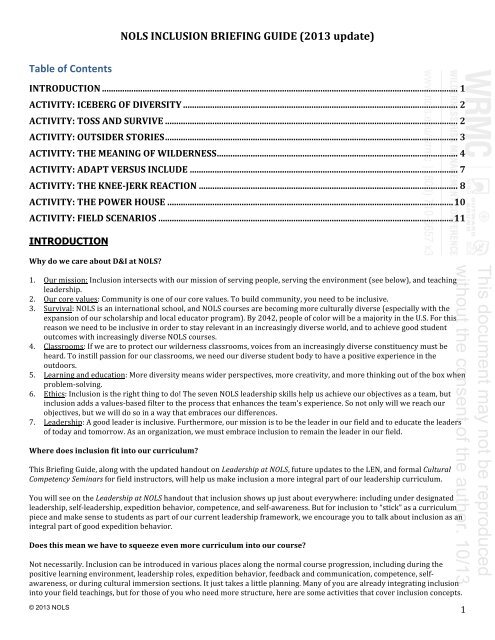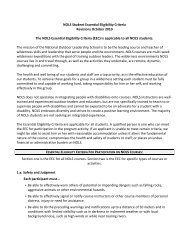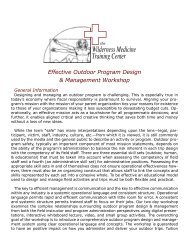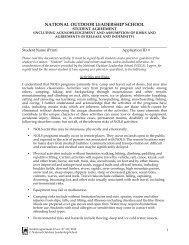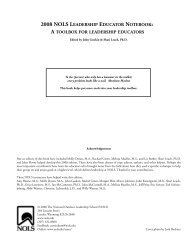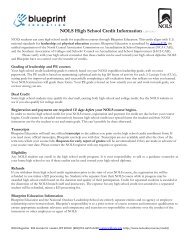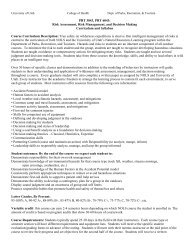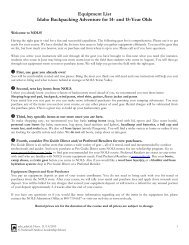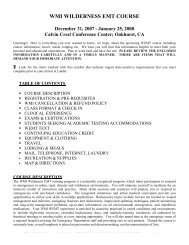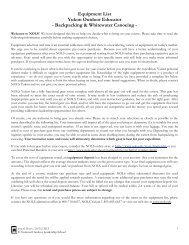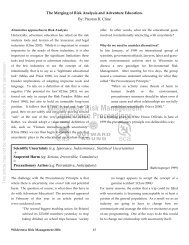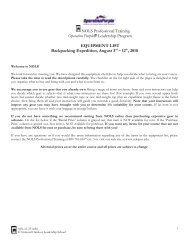2013 Inclusion Briefing Guide (pdf) - NOLS
2013 Inclusion Briefing Guide (pdf) - NOLS
2013 Inclusion Briefing Guide (pdf) - NOLS
You also want an ePaper? Increase the reach of your titles
YUMPU automatically turns print PDFs into web optimized ePapers that Google loves.
© <strong>2013</strong> <strong>NOLS</strong>9 This document may not be reproducedwithout the consent of the author. 10/13
ACTIVITY: FIELD SCENARIOSOnce you have had the opportunity to conduct some of the other D&I activities you can work with students to assess the following real scenarios. Instructor overhears students ribbing another student about an anonymous love letter he received. The students start speculating about the author, and one student says he thinks the letter is from Nina (the only student of color) because “the letter sounds black." Instructor feels this conversation borders on racism. Course leader teaches a bow strokes class in the character of a Kung Fu master, using a fake Chinese accent to speak to the group, and presenting the canoe paddle as a martial weapon to make the analogy that in moving water the bow stroke is an art that has to be mastered. The student group appears to enjoy the class. An Asian-‐American student approaches the patrol leader a few days later to say she was “repulsed” by the class and questions spending part of her summer in such a “white space.” On an I-‐team’s “down time,” the Chilean and Mexican instructor converse casually in Spanish, but strive to speak in English when the American instructor is around and part of the conversation. During the course debrief, the American instructor complains that Spanish-‐speaking instructors should work primarily in Spanish-‐speaking countries, and that if they work in the United States, they should work with two English speakers and speak in English. There is a gay student who is not out to the group and not seeking support around his sexuality; he is happy and well-‐adjusted around the group. The I-‐team, hoping to be “inclusive” talks about “coaching” him into coming out to the group. What actually happened: The course leader appropriately told fellow I-‐team members that it is not their job to “out” students simply to create an inclusive environment—and that it may have the opposite effect. Students should decide for themselves when they would like to “come out” (if at all), and the I-‐team should strive to use language and act in ways that demonstrate they are inclusive and would support the student if he chooses to come out. On a course in <strong>NOLS</strong> Southwest, students make fun of Mexican immigrants crossing the border, indicating that these border crossers don’t understand and revere nature because they litter, and even chase after “owl hoots” at night (owl hooting is how border crossers sometimes communicate with one another). What actually happened: While the student who complained did not do anything during the course, she informed <strong>NOLS</strong> Diversity and <strong>Inclusion</strong> about the event. <strong>NOLS</strong> Diversity and <strong>Inclusion</strong> then worked with <strong>NOLS</strong> Southwest, which now has educational material on the cultural aspects of courses in the Southwest. Program staff strive not only to create an inclusive environment within a course, but to engender respect for the Mexican border crossers in student groups. <strong>NOLS</strong> instructors often bring costumes into the field. A little costume party on a down day often livens things up and boosts morale. But on one such party, the male students dressed up as women, stuffing clothes down their shirts to look like breasts, speaking with an affectation, and prancing about in an attempt to make a caricature of women or transgender individuals. They flirted with other male students, and one female student asked to “motorboat” a male student’s fake breasts. What actually happened: Instructor felt costume parties are so ingrained in <strong>NOLS</strong> culture that she didn’t want to speak out. DeShawn (an African American student) is generally a good influence on the group, but struggles with hiking. After one particularly challenging day, he got into a fight with his tent mate Abir (a student from Afghanistan). DeShawn comes to the I-team and says he is tired of Abir disrespecting him. “He never looks at me when I talk to him,” he says. What actually happened: The instructor team had a conversation with Abir and DeShawn. Abir said that he totally respected DeShawn. In his culture, deference and respect are shown by not looking someone in the eyes. DeShawn realized Abir was not “dissing” him, and the two became friends. An instructor teaches an LNT class to a group of Native American students. The next morning the instructor finds a small pile of food on a rock at camp during the camp sweep. Even after reminding students of LNT principles twice, this continues for two more mornings. What actually happened: I-‐team decided to have a conversation without placing blame or judgment. Students admitted they were leaving offerings to their ancestors. Realizing that this was part of their culture, the instructors decided to ask the students if they could place food items that were biodegradable and minimized environmental impact. The students agreed, and it was decided they would place a small offering of tobacco. This document may not be reproducedwithout the consent of the author. 10/13© <strong>2013</strong> <strong>NOLS</strong>11


